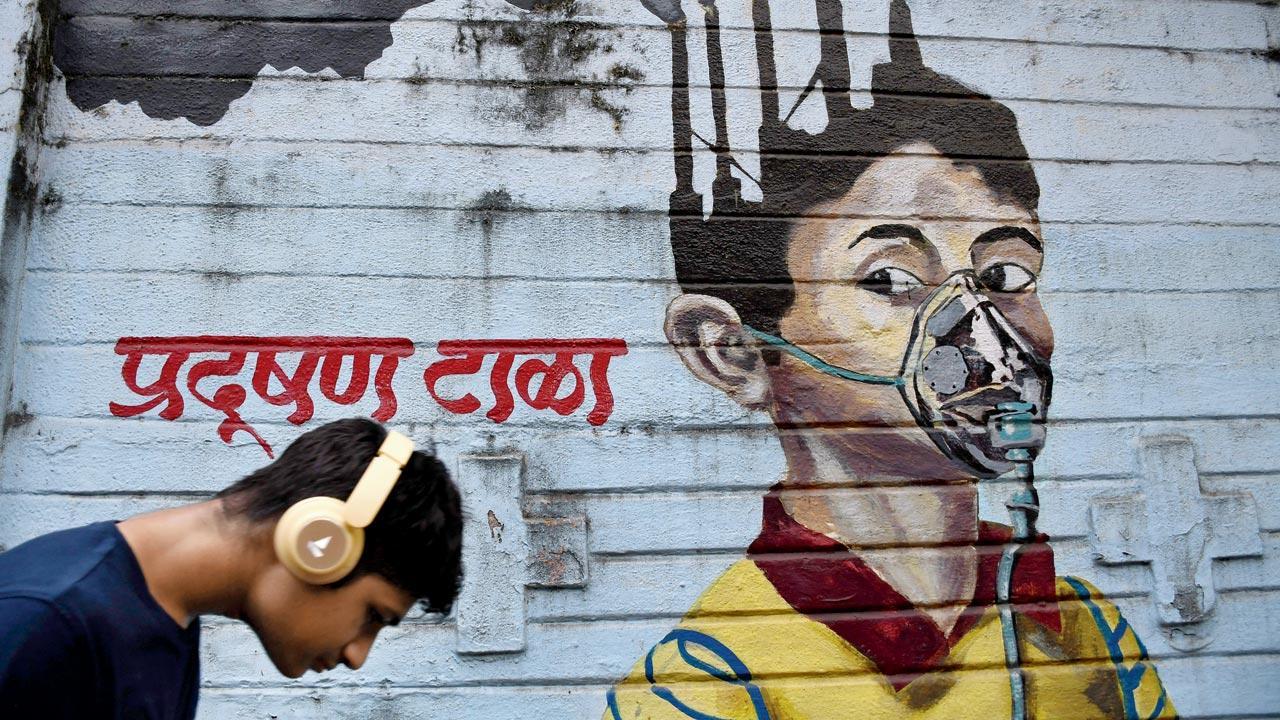A landmark study reveals the startling and direct connection between polluted air and insulin resistance, which messes with the autonomic nervous system and leads to future cardiovascular diseases

A Mumbaikar walks past prophetic wall art earlier this month. Post Diwali, the System of Air Quality and Weather Forecasting And Research (SAFAR-India) recorded the overall AQI for the city at 234 or ‘poor’. Pic/Getty Images
On the subject of chronic or lifelong diseases, most Indians are aware of diabetes’ hold on the population—per the World Health Organisation (WHO) numbers, 77 million people above the age of 18 have Type 2 diabetes. Previously called Adult Onset Diabetes, it refers to high blood sugar or glucose and insulin resistance. Many households are home to people living with and managing the disease with medication and lifestyle changes, or know of a close relative who is. Perhaps what is lesser-known and equally worrying is that 25 million Indians are reportedly pre-diabetic or at risk of developing the disease in the future—people who could benefit greatly from timely medical intervention.
ADVERTISEMENT
A new landmark study highlights what many care providers have estimated in the last few years about the influence of factors in the very environment we live in: exposure to air pollution, that is, particulate matter, affects your blood glucose and is linked to incidence of Type 2 diabetes.
 A child hawks balloon blowers at Marine Drive against a skyline shadowed by dense smog, earlier in January this year. Pic/Getty Images
A child hawks balloon blowers at Marine Drive against a skyline shadowed by dense smog, earlier in January this year. Pic/Getty Images
In their peer-reviewed paper, Siddhartha Mandal, Suganthi Jagannathan, Dimple Kondal and their colleagues from Indian and American institutes studied 12,064 adults living in urban Chennai and Delhi over seven years, from 2010 to 2016. To measure levels of air pollution, they assessed the average daily ambient PM2.5—particulate matter whose nature is fine and inhalable, from a high resolution spatiotemporal model, and people’s exposure to it in the short-term (over a month) and long-term (a year or more).
“Delhi and Chennai were analysed separately, in city-specific models, because the levels of air pollution in both cities are very different. [We found that] Monthly exposure was increasing blood glucose or HbA1C, but long-term exposure increased the risk of developing diabetes in those individuals who don’t have the disease,” Mandal tells mid-day.
 Siddhartha Mandal and Alpana Sowani
Siddhartha Mandal and Alpana Sowani
In their introduction to the paper published in the medical journal, BMJ Open Diabetes Research & Care, the scientists write that previous research on the correlation between air pollution and Type 2 diabetes has originated from high-income countries where there are lower concentrations of PM2.5 and where the population is Caucasian.
“In our country, pollution-centric research has been in engineering disciplines, focusing on what the sources of air pollution are. The effects on health and how to measure these hasn’t been the focus—partly due to lack of robust exposure assessment, proper medical records, and well-designed studies that have followed people over a long period of time,” adds Mandal, who works at New Delhi’s Centre for Chronic Disease Control.
The connection between air pollution and diabetes may not seem apparent, but it concerns the very air we breathe each second. “People already know that their chances of having diabetes increases if their diet is poor, or if they consume too much sugar, or if they don’t exercise. Air is the thing you’re breathing every single day,” he explains. Additionally, though diet and exercise are individual-specific factors, air pollution impacts entire cities. Alpana Sowani, a consultant diabetologist at SL Raheja Hospital, brings to our notice that there is an overall lowering in the age group of people who have Type 2 diabetes.
The study is especially relevant because it is rooted in the Indian context, where Mandal says in present times, most of the disease burden comes from cardiovascular diseases and risk factors like hypertension and diabetes. “Over the last 30 years, the burden of disease has shifted—there’s been an epidemiological transition from communicable diseases to non-communicable ones,” Mandal explains. Air pollution, too, is a major risk factor for mortality in India, he says.
Another consideration is the physiology of Indians and South Asians, which is different from Western populations. “We have low BMI, but high fat content,”
he says.
Sowani explains how air pollution can affect insulin resistance. “PM2.5 particulates infiltrate our airways and cause pro-inflammatory changes and oxidative stress, both of which are contributory factors to insulin resistance.”
“Apart from the inflammatory pathways, PM2.5 may affect insulin resistance by triggering imbalance in the autonomic nervous system, which is also a pathway towards future cardiovascular diseases,” the scientists write in the paper. The autonomic nervous system controls vital involuntary actions, and PM2.5 is known to affect actions such as the heartbeat and arrhythmia (a problem with the rate or rhythm of your heartbeat), Mandal says. “Particulate matter affects the autonomic nervous system and there’s a cascading effect—which affects insulin sensitivity,” he explains. These consequences are what make the study of air pollution and environmental factors like endocrine-disrupting chemicals on human health so essential.
Jagruti Parikh, a senior diabetologist who practices in Thane, says that the study adeptly highlights the possible role of air pollution in the development, control and possible cardiometabolic complications of Type 2 diabetes. “It would benefit if we conducted further long-term studies with controlled population,” she adds.
The paper also addresses how mitigating the impact of air pollution can lead to a palpable change. “At a population level, reducing the monthly average exposures to the first quartile from the third quartile of exposure in each city would potentially reduce the prevalence of diabetes by one per cent to two per cent,” the authors write. Sowani advises making adequate lifestyle changes to counter the environmental influence of air pollution. “Additionally, on days when the pollution levels are higher, consider wearing masks too,” she says.
1-2%
Projected reduction in prevalence of diabetes at a population level if monthly average exposures are reduced to the first quartile from the third quartile
 Subscribe today by clicking the link and stay updated with the latest news!" Click here!
Subscribe today by clicking the link and stay updated with the latest news!" Click here!







